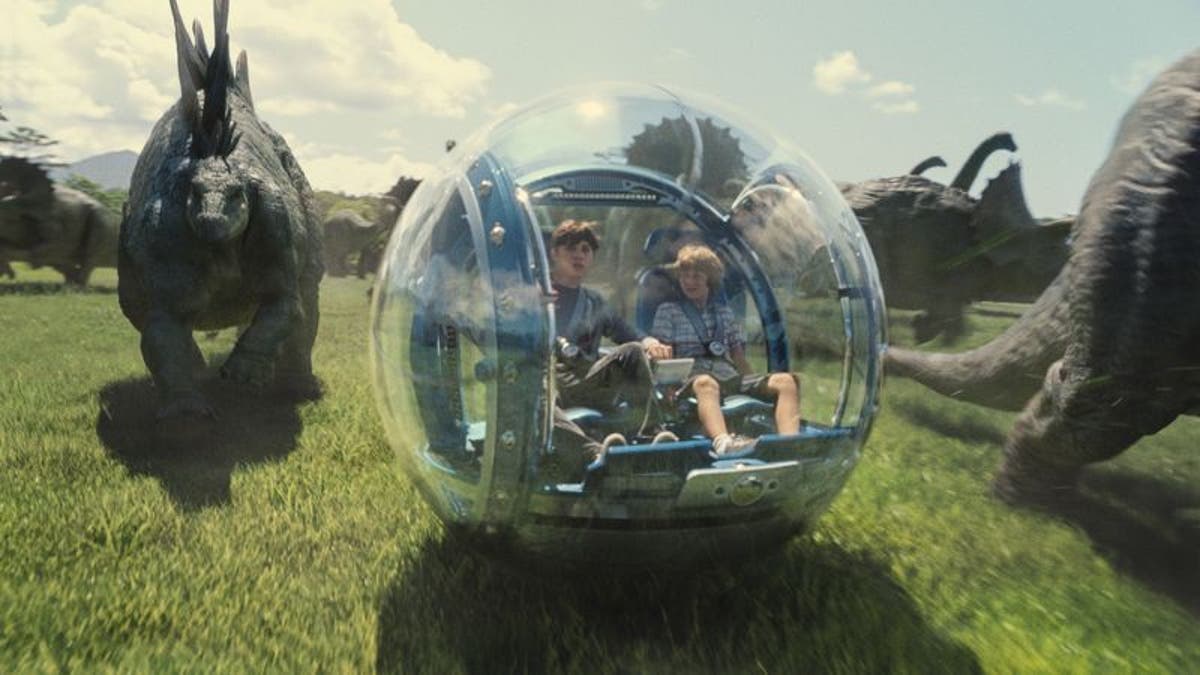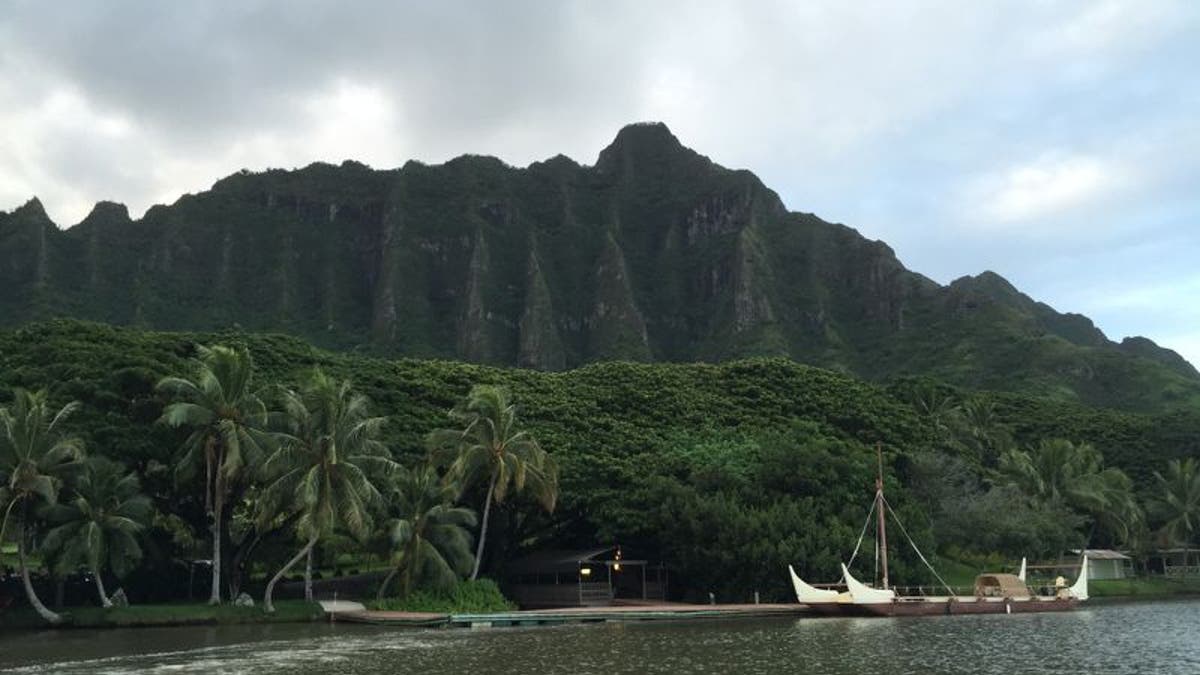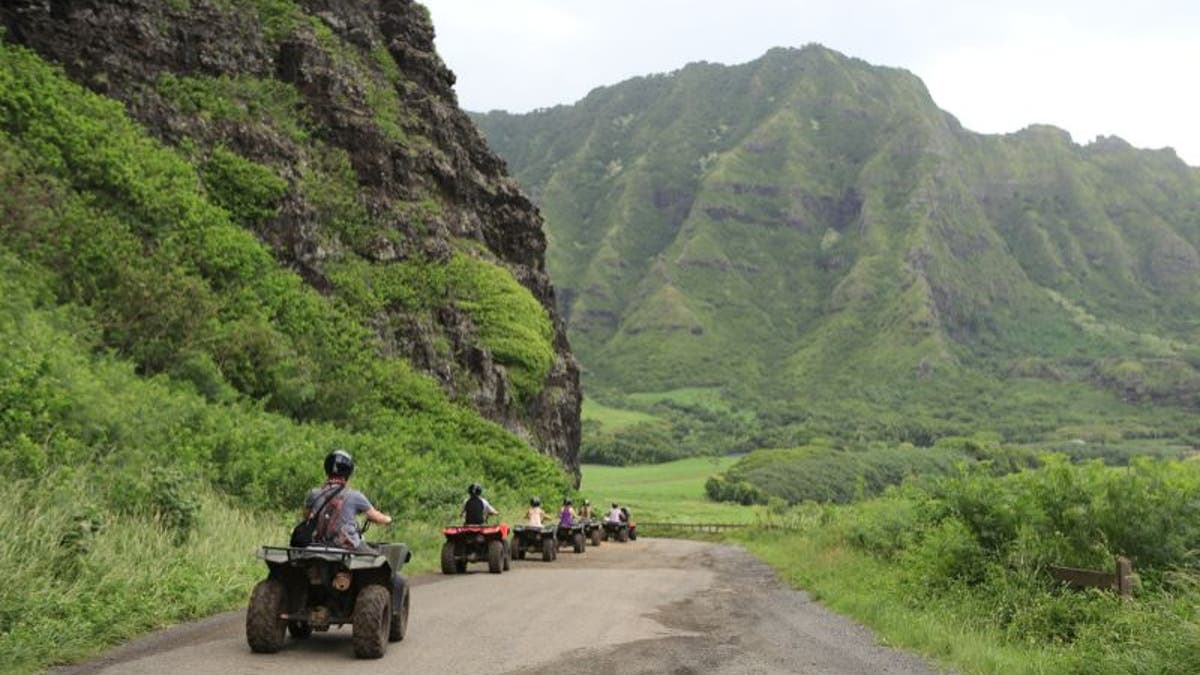
'Jurassic World' park visitors ride alongside dinosaurs in glass spheres. (Universal Pictures)
The lush, green mountains of Isla Nublar rise up over the jungle.
If you squint slightly, edging out any buildings or other people, it’s easy to convince yourself that somewhere in those trees are actual dinosaurs. The overgrown tropical plants, damp with intermittent rain, could hide any number of prehistoric creatures. Thought they look it, these mountains and these plants don’t actually belong to the fictional Central American island overrun with dinosaurs first in 1993’s Jurassic Park and in this year’s sequel Jurassic World. The view, a seemingly perfect setting, is the Hawaiian island of Oahu, which lent itself as a stand-in for Isla Nublar during the shooting of both films.

Views from tropical Kualoa. (Emily Zemler)
During the production of Jurassic World, the fourth film in Steven Spielberg’s franchise and currently the highest grossing film of 2015 — which is out now on Digital HD and comes out on Blu-ray and DVD Oct. 20 — director Colin Trevorrow reimagined Isla Nublar across three Hawaiian islands: Oahu, Maui, and Kauai. The primary shooting, particularly that with stars Chris Pratt and Bryce Dallas-Howard, took place on Oahu, where vestiges of Jurassic World remain. Although it is impossible seek out the T-Rex, there are numerous opportunities for fans of the film to see actual locations and sets from the movie when visiting Hawaii, and it’s becoming big tourism business.
One of the best spots is Kualoa Ranch, a 4000-acre ranch and tourist attraction where Dr. Alan Grant and the kids ran with dinosaurs in the first Jurassic Park. Its ridged peaks, surrounded three separate valleys, have also been used a filming location for everything from Lost to 50 First Dates to Pearl Harbor. (They’re the backdrop for Hurley’s golf course in the first season of Lost, the sight of massive footprints in Godzilla.)
The ranch first launched its tourism component in 1985 for the purpose of sustainability. Now attracts half a million visitors a year, most of whom are interested in the Hollywood aspect of the tours. Kualoa offers zip-lining, horseback riding, and ATV-ing (the latter of which recently drew Nicki Minaj and Meek Mill to the ranch), and in early 2016 they will launch a Hollywood-specific bus tour that will integrate the set pieces from Jurassic World that remain onsite.
“The movie business has been a great symbiotic relationship,” says Kualoa Ranch President John Morgan. “The more things that are filmed here the more people go ‘Oh, that’s great. I want to go there.’ It’s a wonderful thing for us.”

Taking an ATV tour of Kualoa Ranch. (Mario Perez/Universal Pictures Home Entertainment)
The two main Jurassic World attractions at Kualoa are impressive, actual sets that transport you, momentarily, into the world of the film. The first is a massive paddock that, in the movie, was used to hold hybrid dinosaur Indominus Rex (which eventually wrecked havoc across the park). Its walls are 40 feet high and scratched with terrifyingly realistic claw marks. It feels possible, standing inside, that the I-Rex is hiding behind the vegetation, seconds from pouncing. The second set, across the ranch and nestled high on one of the valley’s ridges, is the Gyrosphere launching pad, a platform where spherical vehicles departed in the film’s amusement park.
“We have already seen a lot of interest,” Noelani Schilling-Wheeler, Senior Director of Sales & Marketing at Oahu Visitors Bureau, says of Jurassic World and its ability to encourage fans to visit Hawaii. “Kualoa could have easily torn down everything, but they didn’t because they have a huge impact. People are just interested. Consumers are watching this and many of them are saying they want to go. The connection is right there.”
Kualoa Ranch is the most obvious destination for those chasing a Jurassic World experience, but visitors can also see numerous other locations across Oahu. Atlantis Navatek, the actual boat used to ferry park-goers at the beginning of the film, is based in Honolulu and offers sunset cruises and whale watching tours (during which you can pretend you are headed across the water to visit the fictional park). The Hawaii Convention Center, located near Waikiki, provided the location for several interior scenes (and also stood in for the Sydney airport on Lost). The Pacific Aviation Museum at Pearl Harbor housed the bedraggled survivors at the end of Jurassic World and the Honolulu Zoo’s elephant paddock was reimagined as a dinosaur petting zoo.
As with Lost before it, Jurassic World gave Hawaii an opportunity to reveal its mutability. It’s not simply a collection of tropical islands; it can become another place, even as its signature self remains apparent. Jessica Cole, Jurassic World Production Coordinator, has worked on several films and TV shows around Hawaii. She helped shoot Hunger Games: Catching Fire outside the resort of Turtle Bay and in the jungle of He’eia Kea, and worked on Lost, which is one of the state’s most famous shows.

Chris Pratt and Bryce Dallas-Howard in Jurassic World (Universal Pictures)
“What I like about films like Jurassic World and Hunger Games is there’s a draw to be in a place that’s not just Hawaii,” Cole says. “I think it does a lot for Hawaii to have lots of different facets shown, not just the beach. Not just a palm tree here and there. It’s nice for people to know how much is really here.”
For Cole, Lost was the first real instance of tourists coming to Hawaii for the sole purpose of finding certain shooting locations.
“I think it changed a lot of people’s approach to seeing Hawaii,” she says. “They would specifically make trips to go find places we had shot on Lost. Where was the Dharma Village? Where’s the banyan tree? What was shot in Kualoa? I’ve met a lot of people who will come out here and look for that stuff.”
Now visitors do the same with Jurassic World. It doesn’t seem to matter to visitors that it depicts a fictional place, supposedly located in Central America rather than in the Pacific. The movie’s visuals are enough to lure people to Hawaii.
“For us, it’s a huge part is showcasing the island,” Schilling-Wheeler notes. “It’s a commercial, basically, for the world to see your beautiful destination, whether there’s a lot of CGI in it or not. And there’s a whole generation of people who just love celebrities and what they’re doing. If a celebrity comes here and shoots here, they’re not rushing off usually so that helps. They hang out. There’s a very close connection between the tourism industry and the film industry.”
“Some people like it because the actors came here and if it’s good enough for Jennifer Lawrence or Chris Pratt, then they want to go,” agrees Cole.
Jurassic World star Dallas-Howard spent almost three months in Hawaii shooting the film. She was there so long that her two kids went to school on Oahu during the production. The star has signed on for a sequel and hopes that next film will also shoot on the islands.
“Getting to be here for a length of time longer than a vacation was incredible,” Dallas-Howard says. “I really had the time to take things in. Anything that can encourage someone to take some time and go see one of the most beautiful places on Earth is great. If the movie does bring in visitors, then wonderful.”
“I think Hawaii surpasses what it looks like onscreen,” Cole adds. “It’s so different from people’s normal daily perception of what they see. Whatever we can show them blows people away.”
More from Yahoo! Travel
Is Israel Safe for Tourists Right Now?
How to Help Pay Your Mortgage with Airbnb
Yelp Users Rank the Best B&Bs in America
